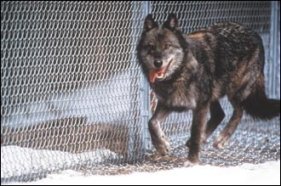|
|
|
 |
|
The wolves were released from these enclosures after three months of acclimation. Each pack was named after the enclosure that had been their acclimation pen. So the three packs were named the Rose Creek Pack, Crystal Creek Pack, and Soda Butte Pack.
The process of holding the wolves together for three months, acquainting them with the locality, and giving them time to mate, was termed "soft release". In contrast the method used with the Idaho wolves, termed "hard release" was to free the wolves immediately upon reaching their release site. The Idaho wolves were released and were roaming inside the wilds of central Idaho by mid-January 1995. Release of the Yellowstone wolves did not begin until late March.
In Montana, wolves did not wait for people to act. In the early 1980s, a pack formed along the Montana/Canadian border, dubbed the Magic Pack. Soon wolves began to drift into Montana, establish packs, and long before the reintroductions to Idaho and Yellowstone there was a growing, naturally restored wolf population in northwestern Montana.
By 1995, the year wolves were reintroduced to Yellowstone and central Idaho, there was an estimate of 87 wolves in northwest Montana. It seemed that wolf restoration (10 packs with pups for three years in a row) would come quickly to the Montana wolf recovery area.
Unfortunately, this was not to be. As of 1998 the population in Montana was declining, with only five reproducing packs identified.
 |
Just last month, January 2000, the 10th Circuit Court in Denver ruled that the wolves, in danger of being removed from their home of the past five years, could stay. |
At the present time, monitoing continues on all the collared wolves, and packs. Many have died along the way. Sadly several were kiled illegally, such as Wolf #10, and Wolf #28, one of the largest in the park. Even more sadly, many have been "legally" killed, by the same people who are meant to protect them.
If certain wolves prey on livestock more than twice, they are removed by lethal means. (It is interesting to note, the majority of the wolves killed for predation, when examined, showed severe tooth damage. It seems they had attempted to chew their way out of their acclimation pens.)
Of course, a great many also met with accidental and natural fatalities, generally involving large vehicles.
The latest news to date is that packs are dispersing, and we are looking forward to new pups from many packs this year.